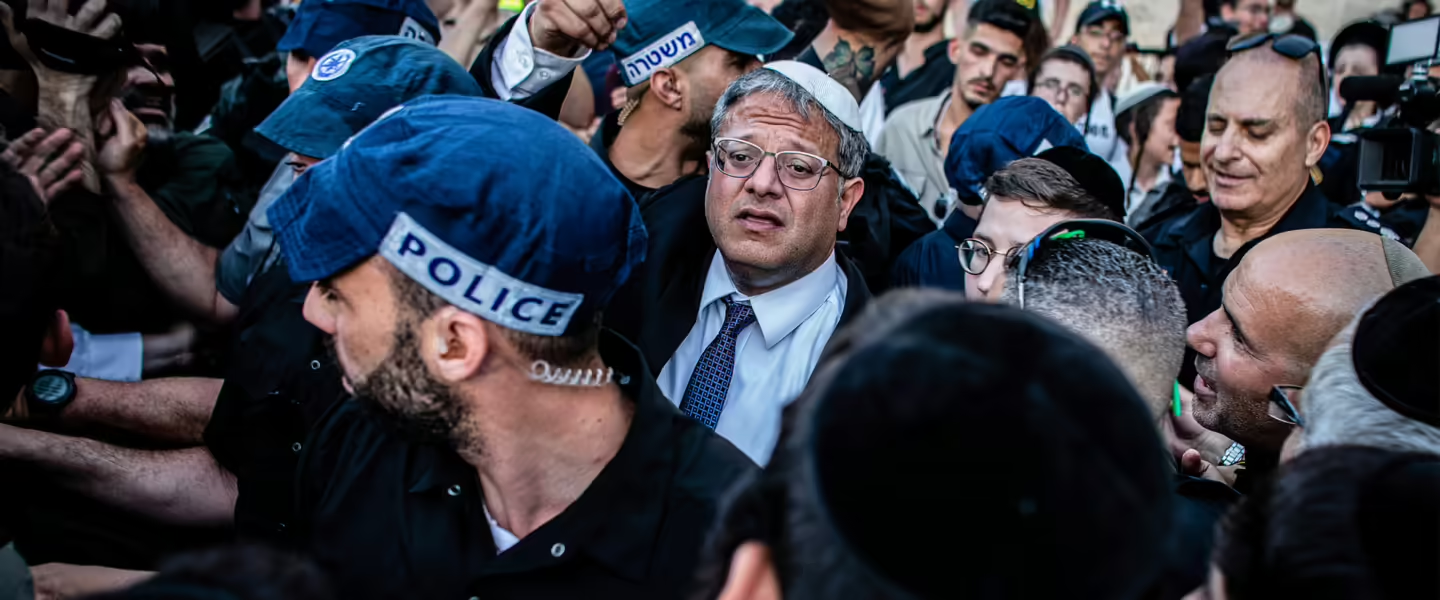Israel’s Minister of National Security, Itamar Ben-Gvir, attempts to sabotage ceasefire negotiations by leading a mob into one of Islam’s holiest sites.
|
Listen To This Story
|
When Israeli National Security Minister Itamar Ben-Gvir stormed the Temple Mount or Haram al-Sharif with up to 3,000 of his singing, dancing, and praying ultranationalist religious followers on Tuesday, August 13, it was fairly clear that the real objective was to sabotage the crucial Gaza ceasefire talks planned for later this week. Those talks will be negotiated by the US, Qatar, and Egypt.
Ben-Gvir carefully timed his provocation to violate long-standing arrangements that allow non-Muslims to visit Islam’s holy sites on the Mount, which is in the heart of Jerusalem’s Old City, but forbid non-Muslims from praying there. A Jordanian-controlled endowment administers the Muslim holy sites on the Mount. Ben-Gvir’s actions were obviously intended to fuel regional tensions.
Ben-Gvir has made no secret that he opposes the Gaza ceasefire talks.
“We must win this war and not go to conferences in Doha or Cairo,” Ben-Gvir said as he strolled across the Mount. “This is the message. We can defeat Hamas.”
The holy site has long been an Israeli-Palestinian flashpoint. Hamas codenamed its October 7 attack against Israel “Operation Al-Aqsa Flood.” The Haram al-Sharif’s Al-Aqsa Mosque is Islam’s third holiest site.
A series of incidents, including the storming of the mosque by Israeli police using tear gas, rubber bullets, and stun grenades, sparked a 10-day Gaza war in 2021.
Fueling the fire, Ben-Gvir, accompanied by National Resilience Minister Yitzhak Wasserlauf and Amit Halevi, a member of Prime Minister Binyamin Netanyahu’s Likud party, emphasized religious aspects of the Israeli-Palestinian conflict, particularly regarding the status of Jerusalem.
Ben-Gvir staged his provocation on Tisha B’Av, the day Jews mourn the destruction of their First and Second Temples in 586 BC and 70 AD.
“We are here on Tisha B’Av, at the Temple Mount, to commemorate the destruction of the Holy Temple. As I said — our policy is to allow prayer,” Mr. Ben Gvir, a West Bank settler leader, said.
Ben-Gvir hoped that his provocation, along with a simultaneous settler assault on the Palestinian village of At-Tuwani in the southern Hebron hills and a controversial settler visit to the tomb of Abraham in Hebron itself, would spark the kind of violence that would either force a cancelation of the ceasefire talks or persuade Iran and/or Hezbollah, the Iranian-backed Lebanese Shiite militia, to strike at Israel sooner than later.
Iran and Hezbollah have vowed revenge for Israel’s recent killing of Hamas political leader Ismail Haniyeh in Tehran and Hezbollah military commander Fouad Shukur in Beirut. Even so, Iran and its Lebanese ally appear to have been holding back to avoid being seen torpedoing the ceasefire talks. A ceasefire would offer Iran and Hezbollah the fig leaf to refrain from retaliating.
Ben-Gvir’s provocations may serve Netanyahu’s purpose as he balances international pressure to agree to a ceasefire that could end the 10-month-old war while insisting the war will continue until Israel has destroyed Hamas militarily and politically, if they produced the kind of violence that would delay or derail the talks.
The question is how long Netanyahu can maintain his ever-more precarious balancing act. His rope to complicate negotiations by making new demands is running thin.
Even so, Netanyahu took Ben-Gvir to task, insisting that “the setting of policy at the Temple Mount is directly subject to the government and the prime minister,” not the national security minister.
The provocations spotlight Netanyahu’s political tightrope with Ben-Gvir and equally far-right Finance Minister Bezalel Smotrich threatening to collapse the government if the prime minister agrees to a ceasefire.
They also highlight the increasing influence of ultranationalists in branches of government, first and foremost, the military.
The settlers in At-Tuwani and Hebron, like in similar past incidents, were accompanied and protected by Israeli troops. In At-Tuwani, soldiers escorted buses carrying the settlers while military snipers occupied rooftops.
Many of the troops are settlers themselves and/or graduates from militant pre-military religious seminaries or yeshivot hesder.
Recent US criticism of Ben-Gvir and Smotrich, who last week described starving Gazans as “moral” and “justified,” should be an indication that the Biden administration will twist Netanyahu’s arm in the ceasefire talks.
It isn’t. Unintentionally, the administration may have strengthened the ultranationalists’ hand by announcing a $20 billion arms sale to Israel at the very moment the United Nations Security Council, including US Ambassador Linda Thomas-Greenfield, decried Israel’s recent attack on a Gaza school that left scores dead.
The sale and the US military build-up in the Middle East allows ultranationalists to argue that the United States will have Israel’s back no matter what it does, including rejecting a ceasefire that would end the war.
None of this bodes well for the success of the ceasefire talks.




